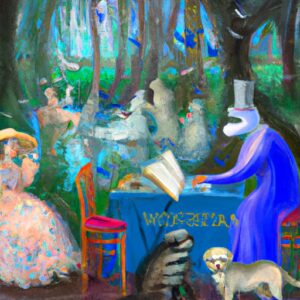How to talk about the past in Italian?
In Italian, past events are indicated by three past tenses: passato prossimo(present perfect), imperfetto (imperfect), and passato remoto(past simple).
Passato remoto is mainly used in Tuscany and areas in the south of Italy. Thus, for practical purposes, we will focus on passato prossimo and imperfetto and how they differ from one another.
Since passato prossimo and imperfetto are used for different purposes and specific contexts it’s important to understand their differences.
What are the differences between passato prossimo and imperfetto?
The main differences between these two tenses are that we use passato prossimo for:
- Talking about past events or actions that happened a while ago but still have an effect on the present.
- Speaking about past events or actions that happened during a limited time, meaning that they started and ended at a specific point in time.
While we use imperfetto for:
- Discussing past events that started and ended during an undetermined, and presumably longer, period of time.
- Describing someone’s appearance or state of mind in the past.
- Talking about someone’s age at a point in the past.
- Describing past habits or habitual actions occurring regularly in the past.
- Describing past situations.
- Describing the weather in the past.
- Describing a scene-setting when telling a story.
When to use passato prossimo or imperfetto?
Don’t worry if you still don’t understand when to use one or the other because is one of the most common mistakes among Italian learners.
This happens because, in English, you tend to use the past simple for almost all past events while in Italian there is a distinction between different events in the past.
It’s pretty normal to get confused but, we’re here to help you understand.
One precious clue is making sure you pay attention to the time expressions used with one or the other.
Passato prossimo: examples
Let’s take a look at some examples:
Ho parlato con Maya ieri.
I spoke to Maya yesterday.
Sono andato a Parigi l’anno scorso.
I went to Paris last year.
Sono andato a trovare mia nonna la settimana scorsa.
I visited my grandmother last week.
And here are some time expressions commonly used with the passato prossimo:
- stamattina (this morning)
- ieri (yesterday)
- ieri sera (last night)
- l’altro giorno (the other day)
- la settimana scorsa (last week)
- il mese scorso (last month)
- l’anno scorso (last year)
- appena (just)
Imperfetto: examples
The following are some examples using imperfetto:
La mia prima bicicletta era bianca.
My first bike was white.
Da piccolo, avevo i capelli castani.
When I was little, I had brown hair.
Mia mamma mi faceva sempre la pasta.
My mother would always make pasta.
And here is a list of some time expressions commonly used with it:
- sempre (always)
- mai (never)
- spesso (often)
- mentre (while)
- tutti i giorni (every day)
- ogni giorno (each day)
- da piccolo (when I was little)
- a volte (at times or sometimes)
- ogni tanto (once in awhile)
How to use passato prossimo and imperfetto together?
We use passato prossimo and imperfetto to describe two past actions happening at the same time in the past.
In other words, we use the imperfetto to talk about what we were doing when something occurred and interrupted what we were doing. It’s the ongoing “background” action.
And we use the passato prossimo for the interrupting action happening for a shorter period of time.
In this situation, we often introduce the imperfetto with mentre (while).
Have a look at the example below:
Mentre andavo in ufficio, ho incontrato Marco.
While I was on my way to the office, I met Marco.
I like this metaphor I was once given to explain the difference between the imperfetto and the passato prossimo:
- In a book, imperfetto would be the behind-the-scenes: setting, character descriptions, weather, time period, anything that will set the tone.
- Passato prossimo is the actual plot of the book: They did this, they went there, they met so and so.
Below we have some examples of these two tenses used in the same sentence:
Ieri facevo la torta quando ha telefonato Miguel.
Yesterday, I was making a cake when Miguel called.
Ho fatto una prenotazione online mentre lui leggeva un libro.
I made a reservation online while he was reading a book.
Studiavamo quando improvvisamente ha squillato il telefono.
We were studying when suddenly the telephone rang.
Mentre camminavolungo il fiume, ho sentito un rumore improvviso.
I was walking along the river when I heard a sudden noise.
Quando David viveva in Italia, ha visitato sia Roma sia Firenze.
During the time David lived in Italy, he visited both Rome and Florence.
Mentre Luca scriveva una e-mail, il computer ha smesso di funzionare.
While Luca was writing an e-mail, the computer stopped working.
Quando lavoravo in quell’azienda, sono andato diverse volte in viaggio d’affari.
When I worked for that company, I went on several business trips.
Mi sono addormentata mentre leggevo.
I fell asleep while I was reading.
Practice with Quizlet
Here's a set of flashcards and quizzes to practice this grammar topic.Passato prossimo or imperfetto: more examples
Let’s now analyze two tricky sentences with passato prossimo or imperfetto.
Can you see the difference between the following two sentences?
Da piccola avevo i capelli biondi.
When I was little I used to have blond hair.
Da piccola ho avuto i capelli biondi.
When I was little I had blond hair.
Avevo refers to a continuous state throughout childhood.
Ho avuto refers to a specific period, which is part of childhood, in which the speaker’s hair was blonde.
Both are complete facts because the speaker is no longer young.
However, the first example covers a long and continuous period, while the second example refers to an instance, maybe long or maybe short, but not the whole period of childhood.










2 Responses
It is not clear how to use the flash cards where the sentence needs to be typed on the line. I would like to use the tool but got them all wrong. It seems one must memorize the sentence (from the earlier multiple choice exercise) that relates to the picture. I would appreciate guidance on this! Thank you!
Ciao Denni!
For using Quizlet in this grammar note you need to conjugate the verb they give you and choose the right sentence for using it.
For example: pranzavo is the verb you need to insert and you have 4 sentences you can to choose from. One is prendere, the second one is andare, and the third and fourth ones are pranzare. The correct answer is the third or fourth one that uses the verb they give you but you need to see which of them corresponds to the verb tense you have.
I hope the explanation was clear but if not, please let me know.